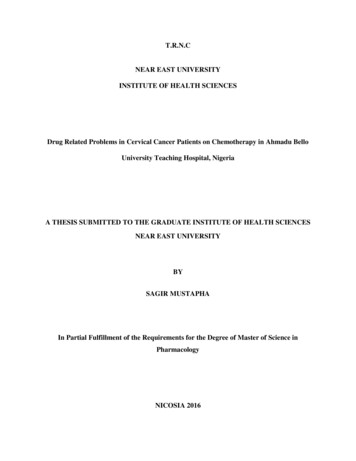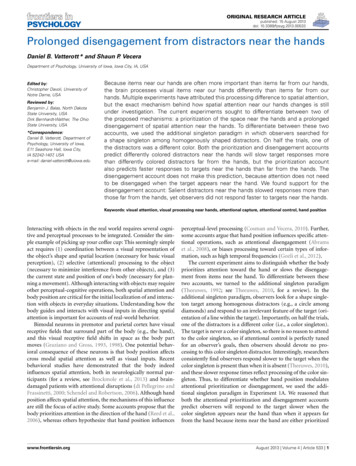
Transcription
T.R.N.CNEAR EAST UNIVERSITYINSTITUTE OF HEALTH SCIENCESDrug Related Problems in Cervical Cancer Patients on Chemotherapy in Ahmadu BelloUniversity Teaching Hospital, NigeriaA THESIS SUBMITTED TO THE GRADUATE INSTITUTE OF HEALTH SCIENCESNEAR EAST UNIVERSITYBYSAGIR MUSTAPHAIn Partial Fulfillment of the Requirements for the Degree of Master of Science inPharmacologyNICOSIA 2016
TURKISH REPUBLIC OF NORTHERN CYPRUSNEAR EAST UNIVERSITYINSTITUTE OF HEALTH SCIENCES, DEPARTMENT OF PHARMACOLOGY‘Drug Related Problems in Cervical Cancer Patients on Chemotherapy in Ahmadu BelloUniversity Teaching Hospital, NigeriaA THESIS SUBMITTED TO THE GRADUATE INSTITUTE OF HEALTH SCIENCESNEAR EAST UNIVERSITYBYSAGIR MUSTAPHAIn Partial Fulfillment of the Requirements for the Degree of Master of Science inPharmacologyNICOSIA 2016ii
TURKISH REPUBLIC OF NORTHERN CYPRUSNEAR EAST UNIVERSITYINSTITUTE OF HEALTH SCIENCES, DEPARTMENT OF PHARMACOLOGYDrug Related Problems in Cervical Cancer Patients on Chemotherapy in Ahmadu BelloUniversity Teaching Hospital, NigeriaSAGIR MUSTAPHAMaster of Science in PharmacologyAdvisorAssoc. Prof. Dr. Bilgen BASGUTNICOSIA 2016iii
DedicationI dedicate this work to Almighty Allah for giving me the knowledge, wisdom and strength. Soalso to my Dad, Mom, Siblings and my entire family for giving me the well-deservedencouragements and supports. To my mentors in Ahmadu Bello University for their unlimitedencouragements. And finally to Kaduna State Government, for making it a reality to studyoverseas.Special thanks to my one and only hocam, Assoc. Prof. Dr. Bilgen Basgut.iv
ApprovalThesis submitted to the Institute of Health Sciences of Near East University in partial fulfillmentof the requirements for the degree of Master of Science in Pharmacology.Thesis Committee:Chair of the committee: Prof. Dr. Nurettin AbacıoğluSig: .Near East UniversityAdvisor:Assoc. Prof. Bilgen BasgutSig: . .Near East UniversityMember:Prof. Dr. A. Tanju ÖzçelikaySig: . .Ankara UniversityApproved by:Prof. Dr. Ihsan ÇALIŞDirector of Health Sciences InstituteSig: . .Near East Universityv
AcknowledgementsMy profound gratitude goes to Almighty Allah (SWT) for His Mercy and Blessings upon me.ALHAMDULILLAH!!!My special appreciation goes to my Advisor, mentor, mother, Assoc. Prof. Dr. Bilgen Basgut forher guide, advice, support and words of encouragement during the course of this research work.Words cannot express my gratitude towards my parents Hajiya Maimuna, Alhaji Mustapha andHjiya Safiya for their moral, spiritual and financial support throughout my study and the progressof this work and also for their parental love and care. May Almighty Allah reward you Jannatulfirdaus. I am very much grateful to my siblings (especially Lukman) and my wife insha ALLAHFatima Sambo Tijjani, for their love, encouragement and support. My family and friends for theirsupport, I say thank you and God bless. I will not forget to acknowledge my dear brother andfriend for always being with me throughout this journey, Pharm. Mustapha (HOD), thanks alot.I appreciate my lecturers and friends in the Departments of Pharmacology and ClinicalPharmacy, Near East University; I say thanks for the moral support.I appreciate the support and encouragement of everyone. I cannot forget to appreciate my friendsand colleagues, too many to mention who stood by me even during the hard times, I am verygrateful for your supports. May Allah reward you all, Ameen.SAGIR MustaphaMaimunat001@gmail.comvi
List of AbbreviationsS/No. AbbreviationsMeaning1. 5FU5-Fluorouracil2. ABUTHAhmadu Bello University Teaching Hospital3. ADRAdverse Drug Reaction4. ASHPAmerican Society of Hospital Pharmacist5. CCTCervical Cancer Treatment6. CINCervical Intraepithelial Neoplasia7. CCSGCervical Cancer Screening Guideline8. CCPCervical Cancer Prevention9. DDIDrug-Drug Interaction10. DRPDrug Related Problem11. FDAFood and Drug Administration Administration12. HPVHuman Papilloma Virus13. NCINational Cancer Institute14. NCCNNation Comprehensive Cancer Network15. NSAIDNon-steroidal Anti-inflammatory Drugs16. PCNEPharmaceutical Care Network Europe17. WHOWorld Health Organisation18. WCRWorld Cancer Reportvii
AbstractDrug-related problem(s) (DRP) is defined as an event or circumstance involving medicationtherapy that actually or potentially interferes with an optimum outcome forspecific patients.The increase in number of available drugs and drug users as well as more complex drug regimens(cervical cancer) lead to more side effects and drug interactions, and complicate follow-up. Theaim of this study is to investigate DRPs in cervical cancer patients receiving chemotherapy.It was a retrospective cross sectional study on patients receiving cervical cancer chemotherapyat Ahmadu Bello University Teaching Hospital, Kaduna-Nigeria. Patients’ medication chartswere reviewed for a period of twelve months (July, 2015 to June, 2016). Data were collectedusing the Pharmaceutical Care Network Europe Classification V 6.2. (PCNE). Then the data wasanalyzed using frequency and percentages.The result of our study shows that 224 DRPs were detected from 65 patients out of 76 that wherescreen for the study. The most prevalence DRPs were treatment effectiveness, adverse drugreaction, treatment cost, drug selection and dose selection with the following percentages(28.13%, 29.02%, 26.79%, 28.13% and 29.02% respectively). The risk factors for DRPs werecomorbidities and number of medications (polypharmacy).In conclusion, drug related problems were significantly common among cervical cancer patientsreceiving chemotherapy in our set up which indicate the need for intervention like involvement ofa pharmacist for better therapeutic results.Keys: Drug related problem, cervical cancer, chemotherapy, polypharmacyviii
OZETix
Table of contentsTitle Pages iDedication .ivApproval letter vAcknowledgement .viList of Abbreviations viiAbstract viiiOzet .ixTable of contents .xList of tables .xiiIntroduction 1Overview .1The aim of the study .2Background .3Cervical cancer 5Sign and Symptoms 5Causes of Cervical cancer .6Diagnosis of Cervical Cancer .8Prevention of Cervical cancer .10Treatment of Cervical cancer .13Treatment Protocol in Cervical cancer .14Epidemiology of Cervical cancer .19Drug Related Problems . 21Prevalence of Drug Related Problems 21Types of Drug Related Problems 23x
DRPs with Anticancer Drugs .36Materials and Methods 38The Study Design .38Data Collection .39Study Population .39Statistical Analysis 39Results 40Demographics 40Drug Use in Chemotherapy .43Types of Problems 44Causes of Problems .45Interactions involving drugs use in Cervical cancer Patients .49Adverse drug reaction .51Relationship between Patients Factors and DRPs .52Pharmacist possible intervention 53Discussion .54Study Limitations .58Conclusion 59Reference .60xi
List of tablesTablesPageTable (1) Age Distribution of Cervical Cancer Patients .40Table (2) Comorbidity .41Table (3) Number of Co-morbid Conditions .42Table (4) Number of Medications .42Table (5) Drugs Used in Chemotherapy .43Table (6) Types of problems 44Table (7) Causes of problems .45Table (8) Contraindications involving drug used in cervical cancer patients .48Table (9) Interactions involving drug used in cervical cancer patients .49Table (10) Adverse drug reaction 51Table (11) Relationship between patients factor and DRP .52Table (12)Pharmacist Possible Intervention .53xii
1.0 Introduction1.1 OverviewCancer of the cervical is a cancer that arises from the cervix (CCT,2014). It is due to irregulargrowth of cells that have the capacity to invade or feast to other parts of the body (NCI,2014).Initially , no symptoms are seen. Later symptoms may comprise abnormal vaginal bleeding,pelvic pain or pain during sexual intercourse (CCT,2014). Human papillomavirus (HPV) arevirus thatappears to be involved in the development of more than 90% of cases ;(Kumar etal,2007;kufe et al,2009). Other risk factors include birth control pills, having many sexualpartners, smoking , starting sex at a young age, and a weak immune system (CCT,2014).Worldwide, cervical cancer is the fourth-most common cancer and cause of death in women(WHO,2014). About 70% of cervical cancers occur in developing countries like Nigeria etc(WCR,2014;WHO,2014) . In developed countries, the widespread use of cervical screeningprograms has dramatically reduced rates of cervical cancer (Canavan et al,2000). Cervical cancerchemotherapy is one of the best approaches to eradicate cancer, its success is far fromsatisfactory due to mostly drug related problems.Drug-related problem(s) (DRP) is defined as an event or circumstance involving medicationtherapy that actually or potentially interferes with an optimum outcome forspecific patients(ASHP, 1993). The increase in number of available drugs and drug users as well as morecomplex drug regimens (cervical cancer) lead to more side effects and drug interactions, and1
complicate follow-up (Ruths et al., 2007). DRPs include adverse drug reactions (ADRs),unnecessary drug therapy, inappropriate choice of drugs, and untreated conditions. DRPs can leadto substantial morbidity and mortality. Drug toxicity is also a major limitation in providinghealthcare to patients at a global level. It affects the patient’s recovery as well as the economy ofhealthcare (Ruths et al., 2007; Leendertse et al., 2008). An inclusive study of DRPs in cervicalcancer patients receiving chemotherapy could provide valuable insights for the healthcareprofessionals to reduce the incidence of DRPs.The aim of this study is to investigate DRPs in cervical cancer patients receiving chemotherapy.Other objectives are to identify the types and frequencies of DRPs in cervical cancer patients, toinvestigate the factors influencing DRPs in cervical cancer patients, to identify the drugsimplicated in the DRPs in cervical cancer patients, to highlight possible interventions on DRPsin cervical cancer patients.2
2. Literature Review2.1 CancerCancer also known as malignancy, neoplasm or tumour, is a group of diseases involvingabnormal cell growth with the potential to invade or spread to other parts of the body. Not alltumours are cancerous; benign tumours do not spread to other parts of the body (WHO, 2014). Atumour is a cluster of cells that have undergone unregulated growth, and will often form a massor lump, but may be distributed diffusely (NCI, 2014).The main features of cancer have been proposed to include; self-sufficiency in growth signalling,insensitivity to anti-growth signals, evasion of apoptosis, enabling of a limitless replicativepotential, induction and sustainment of angiogenesis, and activation of metastasis and invasion oftissue. The development from normal cells to cells that can form a detectable mass to outrightcancer involves multiple steps known as malignant progression (Hanahan and Weinberg, 2011).Many treatment options for cancer exist, with the primary ones including surgery, chemotherapy,radiation therapy, hormonal therapy, targeted therapy and palliative care. Which treatments areused depends upon the type, location, and grade of the cancer as well as the person's health andwishes. The treatment intent may be curative or not curative.3
2.1.1 ClassificationCancers are classified by the type of cell that the tumour cells resemble and are thereforepresumed to be the origin of the tumour. These types include:Carcinoma: Cancer derived from epithelial cells. This group includes many of the most commoncancers, particularly in the aged, and includes nearly all those developing in the cervix, breast,prostate, lung, pancreas, and colon.Sarcoma: Cancers arising from connective tissue (i.e. bone, cartilage, fat, nerve), each of whichdevelop from cells originating in mesenchymal cells outside the bone marrow.Lymphoma and leukaemia: These two classes of cancer arise from hematopoietic (bloodforming) cells that leave the marrow and tend to mature in the lymph nodes and blood,respectively. Leukaemia is the most common type of cancer in children accounting for about 30%(Varricchio, 2004).Germ cell tumour: Cancers derived from pluripotent cells, most often presenting in the testicle orthe ovary (seminoma and dysgerminoma, respectively).Blastoma: Cancers derived from immature "precursor" cells or embryonic tissue. Blastomas aremore common in children than in older adults.Benign tumors (which are not cancers) For example, a benign tumor of smooth muscle cells iscalled a leiomyoma (the common name of this frequently occurring benign tumor in the uterus isfibroid).4
2.2 Cervical cancerCancer of the cervical develops from the cervix (CCT,2014). It is due toirregular growth ofcells that have the capacity to invade or feast to other parts of the body (NCI,2014). Initially, nosymptoms are seen. Later symptoms may comprises abnormal vaginal bleeding, pelvic pain orpain during sexual intercourse (CCT,2014). Human papillomavirus (HPV) are virus that appearsto be involved in the development of more than 90% of cases;(Kumar et al,2007;kufe et al,2009).Other risk factors include birth control pills, having many sexual partners, smoking , starting sexat a young age, and a weak immune system (CCT,2014). HPV vaccines protect against betweentwo and seven high-risk strains of this family of viruses and may prevent up to 90% of cervicalcancers (FDA,2015;HPV,2014;Tran et al 2014). As risk of cervical cancer still exists, guidelinesendorse continuing regular Pap smears (HPV,2014). Treatment of cervical cancer may containsome combination of radiotherapy, chemotherapy and surgery (CCT,2014). Worldwide, cervicalcancer is the fourth-most common cancer and cause of death in women (WHO,2014).2.2.1 Signs and SymptomsThe initial stages of cervical cancer may likely be free of symptoms (kumar et al,2007;Canavanet al,2000). Vaginal bleeding, contact bleeding (bleeding after sexual intercourse), or (rarely) avaginal mass may indicate the presence of malignancy. However, reasonable pain during sexualintercourse and vaginal discharge are indications of cervical cancer. In advanced disease,metastases may be present in the abdomen, lungs, or elsewhere.5
Advanced cervical cancer may have the following symptoms: heavy vaginal bleeding, leg pain,loss of appetite, weight loss, fatigue, pelvic pain, back pain, swollen legs, bone fractures, and/or(rarely) leakage of urine or feces from the vagina (Nanda et al,2007).2.2.2 CausesHPV is the greatest risk factor for cervical cancer, followed by smoking. HIV infection is also arisk factor (Gadducci et al,2011). Not all of the causes of cervical cancer are known. However,several other contributing factors have been implicated (Stuart et al,2006).Human papillomavirus(HPV)Of the 150-200 types of HPV known,(MDL,2007;Gottlieb et al 2007) 15 are classified as highrisk types (16, 18, 31, 33, 35, 39, 45, 51, 52, 56, 58, 59, 68, 73, and 82), three of them areprobable high-risk (26, 53, and 66), and 12 of them are low-risk (6, 11, 40, 42, 43, 44, 54, 61, 70,72, 81, and CP6108) (Munoz et al,2003).HPV types 16 and 18 are the cause of 75% of cervical cancer cases globally. Furthermore, HPV31 and 45 are the causes of another 10% (Robert et al, 2009).Women who have many sexual partners (or who have sex with men who have had many otherpartners) have a greater risk (ACS,2006 ;Marrazzo et al,2001).6
Infection with HPV is generally believed to be required for cervical cancer to occur (Snijders etal,2006).SmokingBoth active and passive smokers have highrisk of developing cervical cancer. Among HPV-infected women, current and former smokers have roughly two to three times the occurrence ofinvasive cancer (CCP,2015).Smoking can increase the risk in women, which can be direct or indirect methods of inducingcervical cancer (Luhn et al,2013;Remschmidt et al,2013). A direct way of contracting this canceris a smoker has a higher chance of CIN3 occurring which has the potential of forming cervicalcancer (Luhn et al,2013). When CIN3 lesions lead to cancer, most of them have the assistance ofthe HPV virus, but that is not always the case, which is why it can be considered a direct link tocervical cancer (Remschmidt,2013). Heavy smoking and long-term smoking seem to have morerisk of getting the CIN3 lesions than lighter smoking or not smoking at all (Jensen et al,2012).Although smoking has been linked to cervical cancer, it aids in the development of HPV which isthe leading cause of this type of cancer (Gadducci et al,2011). Also, not only does it aid in thedevelopment of HPV, but also if the woman is already HPV-positive, she is at an even greaterlikelihood of contracting cervical cancer (Jensen et al,2012).7
Oral contraceptivesLong-term use is related with increased risk of cervical cancer. The used of oral contraceptivesfor 5 to 9 years have about three times incidence of aggressive cancer. Using them for 10 yearsor longer have about four times the risk (CCP,2015).Multiple pregnanciesHaving numerous pregnancies is related with an increased risk of cervical cancer. Among HPVinfected women, those who haveseven or more full-term pregnancies have around four timesthe risk of cancer compared with women with no pregnancies (CCP,2015).2.2.3 DiagnosisBiopsyThe Pap smear can be used as a screening test but is false negative in up to 50% of cases (Cecilmedicine,2015;Berek et al,2014) . Confirmation of the diagnosis requires a biopsy of the cervix.This is often done through colposcopy, a magnified visual inspection of the cervix aided by usinga dilute acetic acid (e.g. vinegar) solution to highlight abnormal cells on the surface of the cervix(Kumar et al,2009).8
Before the biopsy, the doctors ask for medical imaging to rule out other symptoms. Imagingmodalities such as ultrasound, CT scan and MRI have been used to look for alternating disease(Pannu et al,2001).Precancerous lesionsThe potential precursor to cervical cancer are cervical intraepithelial neoplasia(CIN). The term,cervical intraepithelial neoplasia (CIN) was developed to place emphasis on the spectrum ofabnormality in these lesions, and to help standardise treatment (Demay et al,2007). The WorldHealth Organization classification (CR UK website,2009;Demay et al,2007) system wasdescriptive of the lesions, naming them mild, moderate, or severe dysplasia or carcinoma in situ(CIS). It classifies mild dysplasia as CIN1, moderate dysplasia as CIN2, and severe dysplasia andCIS as CIN3. More recently, CIN2 and CIN3 have been combined into CIN2/3. These results arewhat a pathologist might report from a biopsy.2.2.4 Cancer subtypesHistologic subtypes of invasive cervical carcinoma include the following: (Garcia et al,2006) squamous cell carcinoma (about 80-85%) adenocarcinoma (about 15% of cervical cancers in the UK) adenosquamous carcinoma small cell carcinoma9
neuroendocrine tumour glassy cell carcinoma villoglandular adenocarcinomaNon carcinomamalignancies is uncommon and occur in the cervix which include melanomaand lymphoma. The FIGO stage does not include lymph node participation in contrast to theTNM staging for most other cancers2.2.5 StagingCervical cancer is staged by the International Federation of Gynecology and Obstetrics (FIGO)which is based on clinical examination. It permits only these diagnostic tests to be used indetermining the stage: palpation, inspection, colposcopy, endocervical curettage, hysteroscopy,cystoscopy, proctoscopy, intravenous urography, X-ray examination of the lungs and skeleton,and cervical conization.2.2.6 PreventionScreeningUsing the Papanicolaou test or Pap smear for cervical cancer has been attributed withdramatically reducing the number of cases as well as mortality in developed countries (Canavanet al,2000). Pap smear screening every 3–5 years with suitable follow-up can decrease cervicalcancer occurrence up to 80% (Arbyn et al,2010). Irregular results may propose the presence of10
precancerous changes. It allows examination and likely preventive treatment. The treatment oflow-grade lesions may adversely affect subsequent fertility and pregnancy (CCP,2015).European guidelines 2010, the age at which to start screening ranges between 20 and 30 years ofage, "but preferentially not before age 25 or 30 years" (Arbyn et al,2010).In America, screening is recommended to initiate at age 21 and regardlessat which a womanbegan having sex or other risk factors. Pap tests should be done every three years between theages of 21 and 65 (CCSG,2014). Women who are over the age of 65 years, screening may bediscontinued if no abnormal screening results were seen within the previous 10 years and nohistory of CIN 2 or higher exists (CCSG,2014). HPV vaccination status does not changescreening rates . Screening can occur every 5 years between ages 30 and 65 when a combinationof cervical cytology screening and HPV testing is used and this is preferred ( CCSG,2014).Another screening method called Liquid-based cytology. It actually intended to improve on theaccuracy of the Pap test. This reduces the need to recall women for a further smear. The UnitedStates Preventive Services Task Force supports screening every 5 years in those who are between30 and 65 years when cytology is used in combination with HPV testing (Moyer,2012). Indeveloping countries like Nigeria etc Pap smears have not been as effective as it should be . Thisis so because numerous of these countries like (Nigeria etc) have an impoverished health careinfrastructure, insufficient trained and skilled professionals to obtain and interpret Pap smears(WHO,2014).11
Barrier protectionSpermicidal gel or Barrier protection use during sexual intercourse reduce cervical cancer risk(CCP,2015). Condoms offer protection against cervical cancer. Indication on whether condomsprotect against HPV infection is diverse but they may protect against genital warts and theprecursors to cervical cancer (Manhart et al,2014). They also provide protection against otherSTIs which are related with greater risks of developing cervical cancer.VaccinationTwo HPV vaccines (Gardasil and Cervarix) decrease the risk of cancerous or precancerouschanges of the cervix and perineum by about 93% and 62%, respectively. The vaccines arebetween 92% and 100% effective against HPV 16 and 18 up to at least 8 years (CCP,2015).HPV vaccines are typically given to age 9 to 26 as the vaccine is only effective if given beforeinfection occurs. The vaccines have been shown to be effective for at least 4 to 6 years (Harper etal ,2008).The high cost of this vaccine has been a cause for concern. Several countries likeNigeria, Niger etc have consider (or are considering) programs to fund HPV vaccination.12
2.2.7 TreatmentWorldwide, cervical cancertreatmentvaries largely due to access to surgeons skilled inradical pelvic surgery and the appearance of "fertility-sparing therapy" in developed countries.Cervical cancers are radiosensitive at all stages where surgical options do not exist.Micro invasive cancer (stage IA) may be treated by hysterectomy (removal of the whole uterusincluding part of the vagina). Then stage IA2, the lymph nodes are removedas well.Alternatives comprise of local surgical procedures such as a loop electrical excision procedure orcone biopsy (Erstad et al ,2007). For 1A1 disease, a cone biopsy (cervical conization) isconsidered curative.Initial stages (IB1 and IIA less than 4 cm) can be treated with radical hysterectomy with removalof the lymph nodes or radiation therapy. Radiation therapy is given as external beam radiotherapyto the pelvis and brachytherapy (internal radiation). Women treated with surgery who have highrisk features found on pathologic examination are given radiation therapy with or withoutchemotherapy to reduce the risk of relapse.Largely initial-stage tumors (IB2 and IIA more than 4 cm) may be treated with radiation therapyand cisplatin-based chemotherapy, hysterectomy (which then usually requires adjuvant radiationtherapy), or cisplatin chemotherapy followed by hysterectomy. When cisplatin is present, it isthought to be the most active single agent in periodic diseases (FDA,2006).13
Advanced-stage tumors (IIB-IVA) are treated with radiation therapy and cisplatin-basedchemotherapy. On June 15, 2006, the US Food and Drug Administration approved the use of amixture of two chemotherapy drugs, hycamtin and cisplatin, for women with late-stage (IVB)cervical cancer treatment (FDA,2006). Mixture treatment has significant risk of neutropenia,anemia and thrombocytopenia side effects.For surgery to be curative, the whole cancer must be removed with no cancer found at themargins of the removed tissue on examination under a microscope. This procedure is known asexenteration (Sardain et al,2015).Treatment ProtocolsTreatment protocols for cervical cancer are provided below, including treatment by stage,chemoradiation therapy, and chemotherapy.Treatment recommendations for early stage diseaseStage IA1 disease: Primary treatment of early stage cervical cancer is surgery or radiation therapy Treatment recommendations include extrafascial hysterectomy, modified radicaltrachelectomy, or hysterectomy with pelvic node dissection14
Treatment recommendations for stage IA2Stage IA2 disease: Patients with stage IA2 tumors are treated with radical hysterectomy or radicaltrachelectomy with pelvic lymph node dissection Alternative options include brachytherapy with or without pelvic radiation therapy (totalpoint A dose: 75-80 Gy)Treatment recommendations for stage IB and IIAStage IB and IIA: Patients with stage IB or IIA disease can be treated with surgery (radical trachelectomy,pelvic lymphadenectomy, radical hysterectomy plus bilateral pelvic lymph nodesdissection), pelvic radiotherapy or chemoradiation If lymph nodes are positive, then a hysterectomy is not recommended; instead patientshould receive chemoradiation Patients with stage IB or IIA may also be given pelvic radiotherapy and brachytherapywith or without concurrent cisplatin-based chemotherapy Cisplatin 40 mg/m2 IV once weekly (not to exceed 70 mg/wk) plus radiation therapy 1.82 Gy per fraction (minimum 4 cycles; maximum 6 cycles) or Cisplatin 50-75 mg/m2 IV on day 1 plus 5-fluorouracil (5-FU) 1000 mg/m2 continuous IVinfusion on days 2-5 and days 30-33 (total dose 4000 mg/m2 each course) Cisplatin 50-75 mg/m2 IV on day 1 plus 5-FU 1000 mg/m2 continuous IV infusion over24 h on days 1-4 (total dose 4000 mg/m2 each cycle) every 3wk for a total of 3-4 cycles15
Treatment recommendations for advanced stage diseaseStage IIB, IIIA, IIIB, and IVA: Traditionally, advanced disease includes stages IIB-IVA; however, many oncologists nowalso include patients with IB2 and IIA2 in the advanced disease category Treatment recommendations for advanced disease include concomitant chemoradiationand brachytherapy Cisplatin 40 mg/m2 IV once weekly (not to exceed 70 mg/wk) plus radiation therapy 1.82 Gy per fraction (minimum 4 cycles; maximum 6 cycles) or Cisplatin 50-75 mg/m2 IV on day 1 plus 5-fluorouracil (5-FU) 1000 mg/m2 continuousIV infusion on days 2-5 and Days 30-33 (total dose 4000 mg/m2 each course) Cisplatin 50-75 mg/m2 IV on day 1 plus 5-FU 1000 mg/m2 continuous IV infusion over24 h on days 1-4 (total dose 4000 mg/m2 each cycle) every 3wk for a total of 3-4 cyclesTreatment recommendations for metastatic diseaseStage IVB: Patients with metastatic disease are primarily treated with cisplatin-based chemotherapy In addition, individualized radiation therapy should be considered for control of pelvicdisease and other symptomsFirst-line therapy for stage IV recurrent or metastatic disease:16
Bevacizumab 15 mg/kg IV over 30-90 min plus cisplatin 50 mg/m2 IV over 30-90 minon days 1 or 2 plus paclitaxel 135 or 175 mg/m2 IV over 3 or 24 h on day 1 every 3 wkor Bevacizumab 15 mg/kg IV over 30-90 min plus paclitaxel 175 mg/m2 IV over 3 h on day1 plus topotecan 0.75 mg/m2 IV over 30 min on days 1-3 every 3 wk or Paclitaxel 135 mg/m2 IV over 24h (dosing at 175 mg/m2 IV over 3h is also acceptable)followed by cisplatin 50 mg/m2 IV on day 1 every 3wk or Topotecan 0.75 mg/m2 IV (or 0.6 mg/m2 IV if prior radiation therapy) on days 1-3followed by cisplatin 50 mg/m2 IV on day 1 every 3wk or Paclitaxel 175 mg/m2 IV over 3h on day 1 every 3 wkSecond-line therapy for stage IV recurrent or metastatic disease: The National Comprehensive Cancer Network (NCCN) recommends agen
To my mentors in Ahmadu Bello University for their unlimited encouragements. And finally to Kaduna State Government, for making it a reality to study overseas. Special thanks to my one and only hocam, Assoc. Prof. Dr. Bilgen Basgut. v Approval Thesis submitted to the Institute of Health Sciences of Near East University in partial fulfillment .











